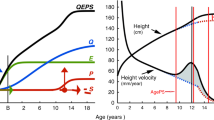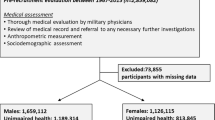Abstract
Objectives:
To contribute to the early risk identification of adult obesity, the anthropometric development in the first 23 years of life as a potential predictor for adult obesity was assessed. To identify the period (7–11 years, 11–16 years and 16–23 years) and type of anthropometric measure difference (weight, height and body mass index (BMI) gains) accounting for the best prediction of obesity at 33 years.
Subjects/Methods:
A total of 4952 members of the 1958 British birth cohort with full information on anthropometric measures. Follow-up examinations at 7, 11, 16, 23 and 33 years were analyzed with receiver-operating characteristics (ROCs).
Results:
Overall 505 cohort members (10.2%) were obese at 33 years. BMI and weight gains between 7 and 11 years were the best-observed predictors for obesity at 33 years with an area under the ROC curve of 0.72 (95% confidence interval (CI): 0.69; 0.74) and 0.73 (95% CI: 0.71; 0.76), respectively. Height gain failed as a significant predictor at any lifetime interval. BMI gain between 7 and 11 years yielded a positive predictive value of 20% (95% CI: 19; 21) compared to 19% (95% CI: 18; 20) for weight gain. The prediction of BMI and weight gains between 7 and 11 years seemed to be unrelated to sex and the onset of puberty.
Conclusions:
High weight or BMI gain from 7 to 11 years should be considered as risk factor of later obesity. These predictors combined with others might allow for targeting preventive measures at a high-risk sub-population.
This is a preview of subscription content, access via your institution
Access options
Subscribe to this journal
Receive 12 print issues and online access
$259.00 per year
only $21.58 per issue
Buy this article
- Purchase on Springer Link
- Instant access to full article PDF
Prices may be subject to local taxes which are calculated during checkout


Similar content being viewed by others
References
Baird J, Fisher D, Lucas P, Kleijnen J, Roberts H, Law C (2005). Being big or growing fast: systematic review of size and growth in infancy and later obesity. BMJ 331, 929.
Brambilla P, Bedogni G, Moreno LA, Goran MI, Gutin B, Fox KR et al. (2006). Crossvalidation of anthropometry against magnetic resonance imaging for the assessment of visceral and subcutaneous adipose tissue in children. Int J Obes (Lond) 30, 23–30.
Bundred P, Kitchiner D, Buchan I (2001). Prevalence of overweight and obese children between 1989 and 1998: population based series of cross sectional studies. BMJ 322, 326–328.
Burdette HL, Whitaker RC, Hall WC, Daniels SR (2006). Breastfeeding, introduction of complementary foods, and adiposity at 5 y of age. Am J Clin Nutr 83, 550–558.
Cheung YB, Machin D, Karlberg J, Khoo KS (2004). A longitudinal study of pediatric body mass index values predicted health in middle age. J Clin Epidemiol 57, 1316–1322.
Choi BC (1998). Slopes of a receiver operating characteristic curve and likelihood ratios for a diagnostic test. Am J Epidemiol 148, 1127–1132.
Cole TJ (1990). The LMS method for constructing normalized growth standards. Eur J Clin Nutr 44, 45–60.
Cole TJ, Faith MS, Pietrobelli A, Heo M (2005). What is the best measure of adiposity change in growing children: BMI, BMI %, BMI z-score or BMI centile? Eur J Clin Nutr 59, 419–425.
De Long ER, DeLong DM, Clarke-Pearson DL (1998). Comparing the areas of two or more correlated receiver operating characteristic curves: a nonparametric approach. Biometrics 44, 837–845.
De Simone M, Farello G, Palumbo M, Gentile T, Ciuffreda M, Olioso P et al. (1995). Growth charts, growth velocity and bone development in childhood obesity. Int J Obes Relat Metab Disord 19, 851–857.
Demerath EW, Schubert CM, Maynard LM, Sun SS, Chumlea WC, Pickoff A et al. (2006). Do changes in body mass index percentile reflect changes in body composition in children? Data from the Fels Longitudinal Study. Pediatrics 117, e487–e495.
Dietz WH (1997). Periods of risk in childhood for the development of adult obesity--what do we need to learn? J Nutr 127, 1884S–1886S.
Dietz WH (1998). Childhood weight affects adult morbidity and mortality. J Nutr 128 (2 Suppl), 411S–414S.
Ekinysmith C, Bynner JM, Montgomery SM, Shepherd P (1992). An Integrated approach to the design and analysis of the 1970 British Cohort Study (BCS70) and the National Child Development Study (NCDS). University of London: London.
Feldman W (1994). Periodic health examination, 1994 update: 1. Obesity in childhood. Canadian Task Force on the Periodic Health Examination. Can Med Assoc J 150, 871–879.
Ferri E (ed). (1993). Life at 33. The Fifth Follow up of the National Child Development Study. National Children's Bureau: London.
Garn SM, LaVelle M, Rosenberg KR, Hawthorne VM (1986). Maturational timing as a factor in female fatness and obesity. Am J Clin Nutr 43, 879–883.
Guo SS, Roche AF, Chumlea WC, Gardner JD, Siervogel RM (1994). The predictive value of childhood body mass index values of overweight at age 35. Am J Clin Nutr 59, 810–819.
He Q, Karlberg J (1999). Prediction of adult overweight during the pediatric years. Pediatr Res 46, 697–703.
Kindblom JM, Lorentzon M, Norjavaara E, Lönn L, Brandberg J, Angelhed J-E et al. (2006). Pubertal timing is an independent predictor of central adiposity in young adult males: the Gothenburg Osteoporosis and Obesity Determinants Study. Diabetes 55, 3047–3052.
Koletzko B, Girardet JP, Klish W, Tabacco O (2002). Obesity in children and adolescents worldwide: current views and future directions—Working Group Report of the First World Congress of Pediatric Gastroenterology, Hepatology, and Nutrition. J Pediatr Gastroenterol Nutr 35 (Suppl 2), S205–S212.
Ogden CL, Troiano RP, Briefel RR, Kuczmarski RJ, Flegal KM, Johnson CL (1997). Prevalence of overweight among preschool children in the United States, 1971 through 1994. Pediatrics 99, E1.
Ong KK, Ahmed ML, Emmett PM, Preece MA, Dunger DB (2000). Association between postnatal catch-up growth and obesity in childhood: prospective cohort study. BMJ 320, 967–971.
Power C, Lake JK, Cole TJ (1997). Body mass index and height from childhood to adulthood in the 1958 British born cohort. Am J Clin Nutr 66, 1094–1101.
Reinehr T, de Sousa G, Roth CL, Andler W (2005). Androgens before and after weight loss in obese children. J Clin Endocrinol Metab 90, 5588–5595.
Rogers I, Ness A, Steer C, Wells J, Emmett P, Reilly J et al. (2006). Association of size at birth and DXA measures of lean and fat mass at age 9–10 years. Am J Clin Nutr 84, 739–747.
Sandhu J, Ben-Shlomo Y, Cole TJ, Holly J, Davey Smith G (2006). The impact of childhood body mass index on timing of puberty, adult stature and obesity: a follow-up study based on adolescent anthropometry recorded at Christ's Hospital (1936–1964). Int J Obes (Lond) 30, 14–22.
Simel DL, Samsa GP, Matchar DB (1991). Likelihood ratios with confidence: sample size estimation for diagnostic test studies. J Clin Epidemiol 44, 763–770.
Stettler N, Stallings VA (2002). Adult obesity and growth in childhood. Association of birth weight with adult weight is confounded by maternal body mass index. BMJ 324, 674.
Toschke AM, Grote V, Koletzko B, von Kries R (2004). Identifying children at high risk for overweight at school entry by weight gain during the first 2 years. Arch Pediatr Adolesc Med 158, 449–452.
Wang Y (2002). Is obesity associated with early sexual maturation? A comparison of the association in American boys versus girls. Pediatrics 110, 903–910.
Whitaker RC, Wright JA, Pepe MS, Seidel KD, Dietz WH (1997). Predicting obesity in young adulthood from childhood and parental obesity. N Engl J Med 337, 869–873.
WHO (2003). Diet, nutrition and the prevention of chronic diseases. In: WHO (ed). WHO Technical Report Series. WHO: Geneva, Switzerland. pp 1–149.
Acknowledgements
We thank the Centre for Longitudinal Studies for the data and the referees for helpful comments on the draft. This study was supported by LMU innovative research priority project MC-Health (sub-project I).
Author information
Authors and Affiliations
Corresponding author
Rights and permissions
About this article
Cite this article
Toschke, A., Rückinger, S., Reinehr, T. et al. Growth around puberty as predictor of adult obesity. Eur J Clin Nutr 62, 1405–1411 (2008). https://doi.org/10.1038/sj.ejcn.1602888
Received:
Revised:
Accepted:
Published:
Issue Date:
DOI: https://doi.org/10.1038/sj.ejcn.1602888



